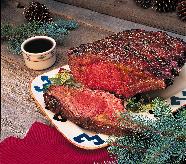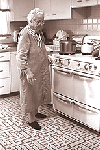
Heat Transfer
|
We have discussed heat transfer and defined it to be the movement of heat. Heat can be transferred from one object to another, like the steak transferring heat to the plate, or heat can be transferred through an object, such as the baking a potato example. But, what is heat? We know we can feel heat. We can say it is a hot day, or the stove is hot, but that doesn't explain what heat is. Heat is energy transferred between two objects because of a temperature difference between them. Heat always travels from hot to cold. So what is the difference between heat and temperature? Temperature is a measure of the energy, or heat, of something. It is a property that an object has based on the random motions of the particles in that substance. The faster that the molecules move, the higher the temperature and therefore the more heat transferred to a new object. Therefore, heat transfer is the movement of energy from something with high energy (a hot object) to something with low energy (a cold object). |
 |
When describing energy or temperature, we need a way to reference how much energy or how much temperature. Saying that it is a temperature of 20 outside does not tell us any information, just like saying a light bulb has an energy of 60. Sixty what? Fahrenheit is a unit of temperature. Other temperature units are degrees Celsius, Kelvin, and Rankine. Units that measure the same thing, such as temperature, can be converted from one to the other. See units. See conversions.
Heat transfer can occur three ways.
-
The first is conduction . Conduction is heat transfer through solids, liquids, and gases. This is the type of heat transfer used in the experiments such as Cooking a Potato, and Heat Transfer from Your Food to Your Plate. It is what allows a potato to cook thoroughly and not just the outer layer of a potato to cook.

-
The second type of heat transfer is convection, which is the transfer of heat due to fluid movement. This is the type of heat transfer used in boiling water. It allows the bottom of the pot of water to remain at relatively the same temperature as the top of the pot of water. Therefore, the top of the pot of water is not cold while the bottom of the pot is hot.

-
The final type of heat transfer is radiation. This is the transfer of heat by a hot source. This type of heat transfer occurs in a hot oven or by electromagnetic radiation, which is how the sun heats the earth.

Heat lost/gained by an object
Units in the heat transfer equations
Proceed to Conduction
Proceed to Convection and Radiation
[Introduction | Kinetics
| Heat Transfer | Mass
Transfer | Bibliography]
This project was funded in part by the National
Science Foundation and is advised by Dr.
Masel and Dr.
Blowers at the University of Illinois.